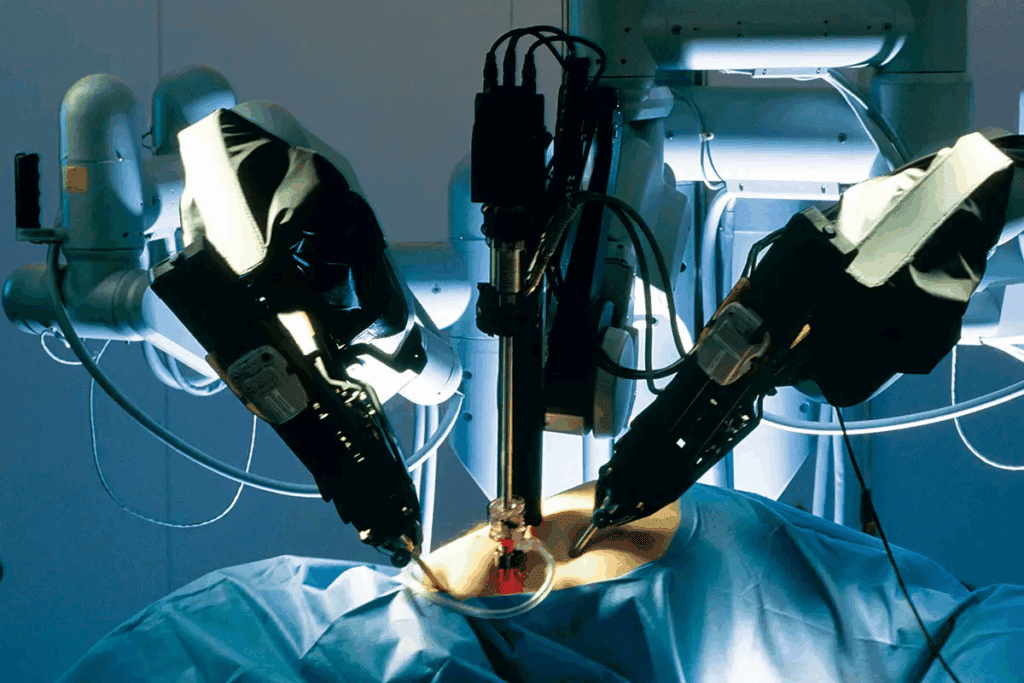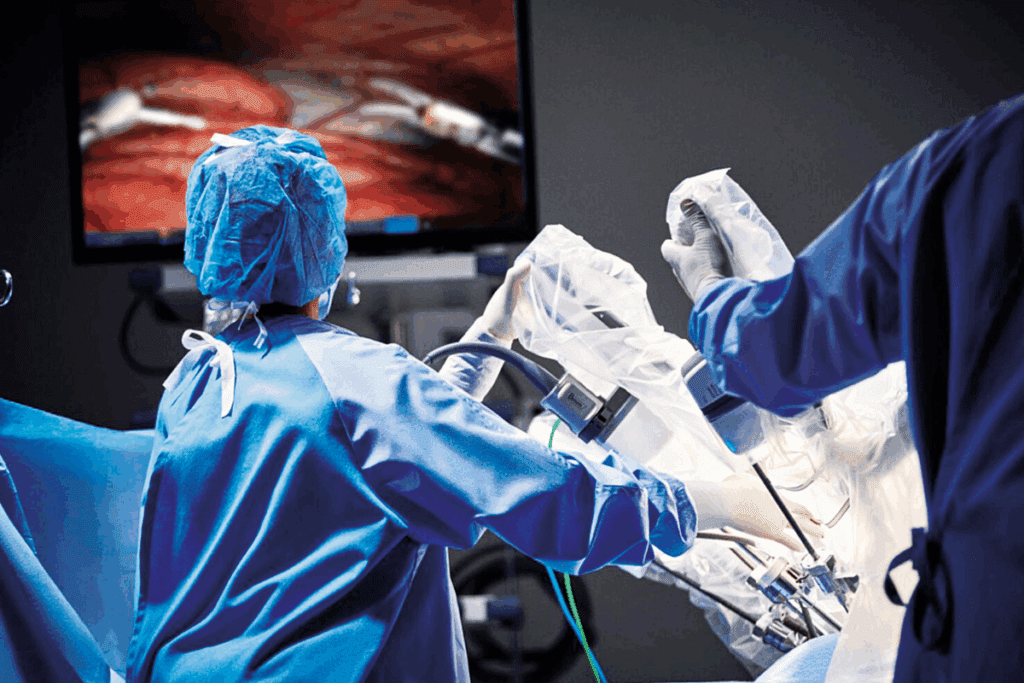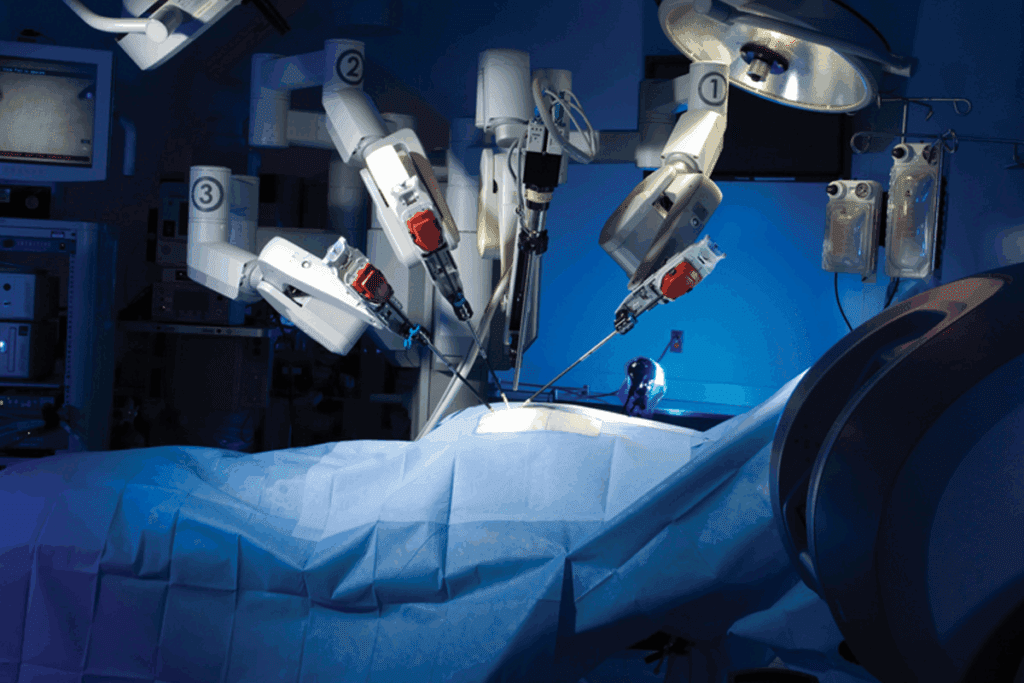Last Updated on November 27, 2025 by Bilal Hasdemir

Robotic surgery has changed the medical world. It offers patients a less invasive option with faster recovery times. Over 1.5 million robotic surgeries are done every year, and this number keeps growing.
We know how key it is to prepare for robotic surgery. Our team is here to support you from the start through your recovery. We want to make sure you have a successful outcome.
We’ll share robotic surgery preparation tips and preoperative instructions just for you. By following our guide, you’ll be ready to play a big part in your robotic surgery patient preparation.

Surgery has changed a lot with robotic surgery. It makes operations more precise and cuts down on recovery time. This method, also known as robotic-assisted surgery, uses a robotic system for surgeries. It lets surgeons do more complex tasks with better accuracy and less invasion.
Robotic surgery technology uses a complex system. It has a console for the surgeon, a cart with robotic arms, and a vision system for clear 3D images. The surgeon’s actions at the console are turned into precise movements by the robotic arms.
This system has advanced features like tremor reduction, motion scaling, and wristed instruments. These features give surgeons the precision and control needed for complex surgeries.
Robotic surgery is used in many areas, like urology, gynecology, and cardiothoracic surgery. It’s used for procedures like prostatectomies, hysterectomies, and coronary artery bypass grafting. These procedures often have less blood loss, less pain, and shorter hospital stays.
As robotic surgery technology gets better, it’s used for more conditions. This opens up new ways to treat diseases with less invasive methods.

Robotic surgery has changed the game in surgery, but we must consider both sides. It uses advanced robots for precise, small cuts instead of big ones. This is a big step up from old ways of surgery.
Robotic surgery has many advantages over traditional methods. It means smaller cuts, less blood loss, and faster healing. The robots help surgeons do tricky tasks with more skill and see better.
“Robotic surgery has changed how we do complex surgeries. It means patients heal faster and feel less pain.”
A study compared robotic and old-school surgeries. Here’s what it found:
| Surgical Aspect | Robotic Surgery | Traditional Surgery |
| Blood Loss | Minimal | Significant |
| Recovery Time | Quicker | Longer |
| Surgical Precision | High | Moderate |
Robotic surgery is great, but it’s not without risks. These can be infections, bleeding, or problems with the tech itself. It’s key to know these risks.
Talking to your surgeon about these risks is important. They can help you understand how to stay safe. Getting ready for surgery means a full check-up and following your doctor’s advice.
In short, robotic surgery is a big plus with its small cuts and fast healing. But, knowing the downsides is just as important. This way, patients can choose the best option for them.
Getting ready for your first meeting with your surgeon is key. This is your chance to talk about your diagnosis, the surgery plan, and what to expect before and after.
It’s important to be ready for this meeting. Bring a list of questions and worries. This helps you understand the surgery better and lets your surgeon know what you need.
Asking the right questions can make you feel more comfortable with the surgery. Here are some important ones to think about:
| Question Category | Example Questions |
| Surgeon’s Experience | How many robotic surgeries have you done? What was your success rate? |
| Procedure Details | Can you explain the steps of my surgery? How long will it take? |
| Recovery and Risks | What are the possible problems? How will pain be handled during recovery? |
After talking about your questions and worries, you’ll need to understand your surgery plan. This includes the details of the procedure, how long you’ll need to recover, and any follow-up care.
Key parts of your plan may include:
Being informed and ready can make your surgery smoother. Don’t be afraid to ask your surgeon anything. Make sure you understand your plan before moving forward.
Before robotic surgery, patients must go through many tests. These tests check if they are healthy enough for the surgery. They help find any health risks and make sure the surgery goes well.
These assessments include a detailed medical history, physical check-ups, and tests. Laboratory tests like blood work and urinalysis look for hidden health issues. Imaging studies like X-rays or MRI scans check the body’s structure and any problems.
Tests like heart checks and lung function tests are also key. They help us understand the patient’s health. This way, we can adjust the surgery plan if needed.
Some patients might need to see specialists before surgery. For example, heart patients might see a cardiologist. Diabetics might see an endocrinologist to manage their blood sugar.
These referrals are important for the patient’s health before surgery. They help lower the risk of problems and improve the surgery’s success. By covering all health bases, we make the surgery safer and more effective.
When you’re getting ready for robotic surgery, knowing the medical details is key. It helps make sure the surgery goes well. Managing your medicines is a big part of this.
It’s important to handle your medicines right before surgery. This helps avoid problems during and after the operation. We’ll show you how to manage your medicines safely.
It’s important to manage your medicines before robotic surgery. Some medicines can make bleeding more likely or affect anesthesia. So, it’s vital to follow your surgeon’s advice on which medicines to keep taking or stop.
Usually, you’ll be told to:
Tell your healthcare team about all medicines you’re taking, including over-the-counter ones and supplements. They can give you personalized advice on managing your medicines.
By following these guidelines for managing your medicines, you can lower the risks of robotic surgery. This helps make sure the surgery is a success.
Good nutrition is key before robotic surgery and helps you recover faster. Eating well can lower the chance of problems and make sure you’re ready for your surgery.
We suggest eating foods full of vitamins, minerals, and antioxidants. This includes fruits, veggies, whole grains, lean proteins, and healthy fats. Drinking lots of water is also important.
To get ready for surgery, eat more protein like lean meats, fish, eggs, and beans. Protein helps keep muscles strong and aids in healing. Also, add colorful fruits and veggies to your meals for lots of vitamins and minerals.
Try to eat less processed foods, sugars, and fats. These can harm your health and make surgery and recovery harder.
It’s vital to follow pre-surgery fasting instructions for your safety. Usually, stop eating solid foods 8-12 hours before surgery. Avoid clear liquids 2-4 hours before. But, these times might change based on your surgery and health, so always listen to your healthcare team.
Drinking water is good, but it’s key to follow fasting rules to avoid surgery risks. If you have fasting questions, talk to your surgeon or healthcare provider.
Before robotic surgery, getting your body ready is key. Good physical prep can make your recovery better and your surgery results better. Focus on exercises that boost your health and energy.
Regular exercise before surgery can lower risks and speed up healing. Mix cardio, strength training, and flexibility exercises in your routine.
Enough rest and sleep are vital before surgery. Good sleep helps your body heal faster after surgery. Aim for a consistent sleep schedule and a cozy sleep space.
Combining a good exercise plan with enough rest and sleep boosts your prep for robotic surgery. It also improves your recovery.
Getting ready for robotic surgery is more than just physical prep. It’s also about getting your mind and emotions ready. As your surgery date gets closer, focusing on your mental and emotional state is key. This ensures a smooth and positive experience for you.
Handling surgical anxiety is a big part of getting mentally ready for robotic surgery. Deep breathing, meditation, and visualization can calm your nerves and lower stress. “Fear and anxiety are natural when facing surgery, but the right strategies can help manage them,”.
Also, knowing what to expect during surgery can lessen your anxiety. Your healthcare team can guide and support you. This helps you feel more ready and confident.
Having a strong support network is essential for emotional prep. Surround yourself with loved ones who can offer emotional support and practical help during recovery. A good support network can greatly improve your mental and emotional health.
Think about joining a support group for robotic surgery patients. Sharing your journey and connecting with others facing similar challenges can be very helpful. As one patient shared, “Being part of a support group made a huge difference in my recovery. It was comforting to know I wasn’t alone.”
Understanding your insurance coverage is a key step in preparing for robotic surgery. As you move forward with your surgical plans, it’s essential to have a clear grasp of your financial obligations and how your insurance can help.
Most insurance providers cover robotic surgery for various procedures, but the extent of coverage can vary. We recommend that you:
By taking these steps, you can better understand your insurance coverage and avoid any unexpected financial surprises.
Even with insurance coverage, there may be out-of-pocket expenses associated with robotic surgery. These can include:
To manage these expenses, we suggest creating a budget and exploring financing options if necessary. Our team can also provide guidance on what to expect and how to plan.
Getting ready for your robotic surgery is a big deal. The day before is key for getting your home ready and packing for the hospital. We’ve made a detailed checklist to help you stay organized and prepared.
Getting your home ready for when you get back is important. Here are some things to do:
| Task | Status |
| Clean and declutter the home | |
| Prepare meals in advance | |
| Set up a comfortable recovery area | |
| Purchase essential supplies |
Packing the right things for the hospital can really help your comfort and recovery. Here are some must-haves:
By using this checklist, you’ll be all set for your robotic surgery. Focus on your recovery. If you have any questions or worries, talk to your healthcare provider.
On the day of your robotic surgery, we’ll guide you through every step. This ensures a smooth experience. Knowing the process can help reduce anxiety and make the day easier.
When you arrive at the hospital, you’ll go to the registration area. Our staff will check you in. Make sure you have your ID, insurance, and any needed documents.
Then, you’ll move to a pre-operative area. Here, you’ll change into a hospital gown and get ready for surgery.
Key steps upon arrival include:
Before surgery, our team will help you prepare. This includes giving you anesthesia and making sure you’re comfortable. You’ll be positioned for the robotic surgery.
During this time, we’ll also:
By knowing these steps, you’ll feel more confident and ready for your surgery. Our team is committed to giving you the best care and support.
Before robotic surgery, make your home ready for a smooth recovery. A well-organized space helps you heal better. It lets you focus on resting and getting better.
We know a good recovery is key. We’ll help you get your home ready for post-surgery care.
Think about what makes a good recovery space. Find a quiet, comfy spot in your home. It should be easy to get to and on the main floor to avoid stairs.
Key Elements of a Recovery-Friendly Space:
A well-prepared recovery space can make a significant difference in a patient’s comfort and recovery speed.
“The environment in which we recover plays a critical role in our healing. By creating a peaceful and comfortable space, patients can better focus on their recovery.”
Having the right supplies and equipment can improve your recovery. Here are some must-haves:
| Supply/Equipment | Purpose |
| Comfortable clothing | Easy to wear and change into without exerting yourself |
| Medications and prescriptions | As directed by your healthcare provider |
| Water and nutritious snacks | To stay hydrated and nourished during recovery |
Also, have extra supplies like ice packs, heating pads, and a thermometer ready. They can help with any pain or discomfort after surgery.
Preparing your home for recovery can make it more comfortable and stress-free. Remember, your recovery is as important as the surgery. With the right preparation, you can heal well.
Getting ready for robotic surgery means looking at many areas. This includes your health, diet, physical shape, and how you feel. By using the robotic surgery preparation tips from this article, you can get ready well and recover quickly.
The keys to preparing for robotic surgery are clear. First, learn about the surgery. Then, manage your medicines and eat right. Building a support network is also key. Don’t forget to get in shape, mentally prepare, and plan your finances to reduce stress.
Good robotic surgery patient preparation helps avoid problems and speeds up healing. By listening to your healthcare team and taking steps to prepare, you can get the most out of robotic surgery. This way, you’ll have the best results possible.
Robotic surgery is a new way to do surgery. It uses a robot to help the surgeon. The robot has a console, a cart for the patient, and a special vision system. This lets the surgeon make very precise and delicate moves.
Robotic surgery is good because it’s less invasive. It means less blood loss, less pain, and a quicker recovery. It also helps the surgeon be more precise, which lowers the risk of problems.
To get ready for a consultation, write down questions for your surgeon. Ask about the procedure, risks, and recovery. Also, share your medical history and any test results.
The tests you need depend on the surgery and your health. You might need blood work, imaging, and heart checks. Your surgeon will tell you what tests you need.
Always follow your surgeon’s advice on medications before surgery. You might need to stop or change some medicines, like blood thinners, to avoid bleeding.
Eat well before surgery. Focus on fruits, veggies, and whole grains. You might also need to fast before the procedure.
Get your body ready by exercising lightly, like walking. Also, rest well before the surgery.
To deal with anxiety, build a support network. Try relaxation techniques like deep breathing or meditation. Talk to your surgeon about your worries.
On surgery day, arrive at the hospital and get ready. Then, you’ll go to the operating room. Our team will help you feel safe and comfortable.
Make your home comfy for recovery. Get supplies like pain meds and ice packs. Also, have family or friends ready to help.
Robotic surgery, like any surgery, has risks. These include bleeding, infection, and reactions to anesthesia. Your surgeon will talk about these risks with you.
To know about your insurance, call your provider. Ask about your benefits and what you might have to pay out of pocket.
Subscribe to our e-newsletter to stay informed about the latest innovations in the world of health and exclusive offers!